Papers by Howard Dubowitz
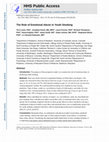
American Journal of Preventive Medicine, 2019
Introduction: The purpose of this prospective study is to examine the role of emotional abuse in ... more Introduction: The purpose of this prospective study is to examine the role of emotional abuse in predicting youth smoking. Methods: Data were drawn from the Longitudinal Studies of Child Abuse and Neglect. The sample was restricted to those who had an interview at age 12 years and at least one interview at ages 14, 16, or 18 years (n=775). Self-reported smoking at ages 14, 16, and 18 years was the timevarying dependent variable. Peer and household smoking were modeled as time-varying predictors. Type of abuse, youth sex, race/ethnicity, history of child neglect, and study site were modeled as time-invariant predictors. Dates of data collection from age 4 years to age 18 years range from July 1991 to January 2012. Analyses were conducted in 2017. Results: After controlling for a history of neglect, sex, race/ethnicity, study site, household and peer smoking, those with physical and/or sexual abuse only, or emotional abuse only, were at no greater risk of smoking compared with the no abuse group. However, those classified as having a combination of physical and/or sexual abuse and emotional abuse were at significantly greater risk for youth smoking compared with those with no reported physical/sexual or emotional abuse (β=0.51, z=2.43, p=0.015). Conclusions: Emotional abuse, in combination with physical and/or sexual abuse, predicted youth smoking, whereas the other types of abuse (physical and/or sexual abuse), or emotional abuse alone, did not. Considering the important health implications of early smoking initiation, it is important to document critical influential factors to better inform intervention efforts.
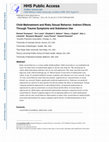
Child maltreatment, Jan 24, 2016
Risky sexual behavior is a serious public health problem. Child sexual abuse is an established ri... more Risky sexual behavior is a serious public health problem. Child sexual abuse is an established risk factor, but other forms of maltreatment appear to elevate risky behavior. The mechanisms by which child maltreatment influence risk are not well understood. This study used data from 859 high-risk youth, followed through age 18. Official reports of each form of maltreatment were coded. At age 16, potential mediators (trauma symptoms and substance use) were assessed. At age 18, risky sexual behavior (more than four partners, unprotected sex, unassertiveness in sexual refusal) was assessed. Neglect significantly predicted unprotected sex. Substance use predicted unprotected sex and four or more partners but did not mediate the effects of maltreatment. Trauma symptoms predicted unprotected sex and mediated effects of emotional maltreatment on unprotected sex and on assertiveness in sexual refusal and the effects of sexual abuse on unprotected sex. Both neglect and emotional maltreatment ...
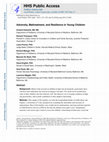
Academic pediatrics, Jan 8, 2016
Much of the research on children in high risk environments, particularly those who have been malt... more Much of the research on children in high risk environments, particularly those who have been maltreated, has focused on negative outcomes. Yet, much can be learned from some of these children who fare relatively well. The objective was to examine resilience in high risk preschoolers, and to probe contributors to their adaptive functioning. The sample of 943 families was from the Longitudinal Studies on Child Abuse and Neglect (LONGSCAN), a consortium of 5 sites, prospectively examining the antecedents and outcomes of maltreatment. Most of the families were at high risk for maltreatment, and many had been reported to Child Protective Services by age 4. Standardized measures were used at ages 4 and 6 to assess the children's functioning in Behavioral, Social and Developmental domains, and parental depressive symptoms and demographic characteristics. Maltreatment was based on CPS reports. Logistic regressions were conducted to predict resilience, defined as competencies in all thre...
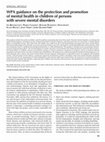
World Psychiatry, 2011
The United Nations (UN) Convention on the Rights of the Child (1) affirmed that the child, for th... more The United Nations (UN) Convention on the Rights of the Child (1) affirmed that the child, for the full and harmonious development of his/her personality, should grow up in a family environment, in an atmosphere of happiness, love and understanding. Nations must take appropriate measures to protect the child from all forms of physical or mental violence, maltreatment or exploitation, while in the care of parents or other persons entrusted with their care. This Convention was adopted by the UN General Assembly in November 1989, and has been ratified by 192 nations. It is not only because of this authoritative pronouncement, but also because the ambition of medicine is to prevent disease, that the issue of the mental health of children of mentally ill parents is important: a promising preventive strategy is to work with high risk groups, such as these vulnerable children. Most of these children are born and reared in low-income nations, which have a dearth of resources and also, in some cases, of essential knowledge. There is a paradoxical relationship between wealth and birth rates: nations in Europe, North America and elsewhere, with advanced health systems and strong scientific contributions, have fewer than 10 million births/year. We are concerned not only to improve practice in these nations, but also and especially to find solutions for those countries in which the other 125 million infants are born. Thus, we seek to recommend state-of-the-art
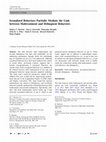
Journal of Child and Family Studies, 2014
The link between child maltreatment and juvenile delinquency has been well established, yet the u... more The link between child maltreatment and juvenile delinquency has been well established, yet the underlying mechanisms through which the relationship may be explained are not very well understood. Although sexualized behaviors have been most studied in the context of sexual abuse, increasing evidence suggests that a broader conceptualization is warranted. Therefore, the current study tested sexualized behaviors as a mediator in the relation between child maltreatment of any type and delinquent behaviors using structural equation modeling. This study used a multi-site prospective sample of 804 children who were at high-risk for experiencing maltreatment and part of the Longitudinal Studies of Child Abuse and Neglect consortium. This study found that reported maltreatment was related to delinquency, and sexualized behaviors partially mediated the relationship between child maltreatment and juvenile delinquency. Specifically, children with more maltreatment reports before age 8 had increased sexualized behaviors at age 8, which in turn predicted greater delinquent behaviors at age 12. These results suggest that in addition to maltreatment experiences, early sexualized behaviors (i.e., at age 8) may also be markers for subsequent delinquent behaviors (i.e., at age 12). Researchers and clinicians should work to further clarify the connections among child maltreatment, sexualized behaviors, and delinquency.
New Directions in Failure to Thrive, 1985
The title of this chapter contains an apparent contradiction. If nonorganic failure to thrive (NO... more The title of this chapter contains an apparent contradiction. If nonorganic failure to thrive (NOFT) has organic factors contributing to its etiology, then must “nonorganic” be a misnomer? This chapter will focus on these organic concomitants of NOFT. Before embarking on this description, examination of the traditional taxonomy of failure to thrive (FTT) is warranted.
Child Abuse & Neglect, 2014
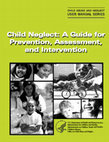
PsycEXTRA Dataset
While the User Manual Series primarily addresses the issues of child abuse and neglect, this manu... more While the User Manual Series primarily addresses the issues of child abuse and neglect, this manual delves deeper into the root causes, symptoms, and consequences of neglect, as well as the interdisciplinary ways to prevent both its occurrence and recurrence. Readers of Child Neglect: A Guide for Assessment, Prevention, and Intervention also may be interested in Child Protective Services: A Guide for Caseworkers, which goes into more depth on issues such as family assessment and case planning. They also may have interest in A Coordinated Response to Child Abuse and Neglect: The Foundation for Practice, the keystone for the series, which addresses the definition, scope, causes, and consequences of child abuse and neglect. It Child Neglect: A Guide for Prevention, Assessment, and Intervention presents an overview of prevention efforts and the different professional groups and offers guidance on how the groups can work together effectively to protect the safety, permanency, and well-being of children. child protection process. Because child protection is a multidisciplinary effort, The Foundation for Practice describes the roles and responsibilities of User Manual Series

Pediatrics, 2008
OBJECTIVES. To estimate the prevalence of intimate partner violence among parents at a pediatric ... more OBJECTIVES. To estimate the prevalence of intimate partner violence among parents at a pediatric primary care clinic and to evaluate the stability, sensitivity, specificity, positive and negative predictive values, and likelihood ratios of a very brief screen for intimate partner violence. METHODS. A total of 200 parents (mostly mothers) bringing in children less than 6 years of age for child health supervision completed the Parent Screening Questionnaire in a primary care clinic. The Parent Screening Questionnaire, a brief screen for psychosocial problems developed for the study, includes 3 questions on intimate partner violence. Mothers then completed the computerized study protocol within 2 months. This included the Parent Screening Questionnaire as well as the Revised Conflict Tactics Scale. Different combinations of the intimate partner violence questions were evaluated against the Revised Conflict Tactics Scale. RESULTS. A total of 12.0% of the mothers answered “yes” to at lea...
Pediatric Clinics of North America, 2009

The Journal of Early Adolescence, 2010
Little is known about the early childhood indicators of adolescent risk. The link between traject... more Little is known about the early childhood indicators of adolescent risk. The link between trajectories of externalizing behavioral problems and early adolescent risk behavior was examined in a longitudinal sample of 875 child participants in the LONGSCAN studies. Five trajectory groups of children defined by externalizing behavior problems were identified: Low, Low-Medium, Moderate, Increasing-High, and High. After controlling for demographics and maltreatment, violent/delinquent behavior was significantly predicted by membership in the Moderate and Increasing-High problem behavior groups. Substance use in early adolescence was significantly predicted by membership in the High behavior problem group. These findings suggest that there is a great deal of continuity between patterns of externalizing behavior in childhood and risk-taking in early adolescence. Understanding the course of externalizing behavior in childhood can help identify children at particular risk for more serious be...

Journal of Developmental & Behavioral Pediatrics, 1993
An increasing number of children needing out-of-home care are being placed with relatives. Despit... more An increasing number of children needing out-of-home care are being placed with relatives. Despite this pervasive policy, there has been scant research on children in this arrangement called kinship care. The objectives of this study were (1) to assess the behavior of children in kinship care and (2) to identify predictors of their behavior. The caregivers of 346 children in kinship care completed the Child Behavior Checklist (CBCL). Background information was obtained from caregivers and caseworkers. Forty-two percent of boys and 28% of girls had overall CBCL scores in the clinical range, compared with an expected 10% in the general population. Logistic regressions revealed several variables significantly associated with behavior problems including: reason for placement, gender, race, caregiver's perception of the child, caregiver's educational level, number of contacts between caregiver and caseworker, long-term plan, and child's age. The frequent behavior problems among these high-risk children in kinship care suggest they all deserve mental health evaluations; at a minimum, periodic screening is indicated.
Journal of Clinical Child Psychology, 1995
... superklslon, fo<)d, clothing, and shelter ma) be neglected :Cn:renden. 1992 r ... more ... superklslon, fo<)d, clothing, and shelter ma) be neglected :Cn:renden. 1992 r Cornpared to nunneglected children, neglected chlldrer, habe ugnihcantl~ lower scores on standard-zed ieds of cognitlie. motor, and ianguage deveiop-1neri.l 1,4ilen Er Oliier, i 982, Crittenden. ...
Journal of Child Sexual Abuse, 2003
Journal of Family Violence, 2003
The impact of maternal victimization on the behavioral, social, emotional, and cognitive developm... more The impact of maternal victimization on the behavioral, social, emotional, and cognitive development in a group of 206 low-income, predominantly African American children from inner city, pediatric primary health care clinics was explored using mother, teacher, and self-report data. Results revealed that mothers with a victimization history reported more externalizing and internalizing behaviors in their children, compared to mothers who

Criminal Justice and Behavior, 1993
Although child neglect is the most common form of child maltreatment, considerable confusion rema... more Although child neglect is the most common form of child maltreatment, considerable confusion remains regarding its definition. A conceptual definition of neglect is presented based on an ecological model of child maltreatment. The definition focuses on the basic needs of children that are not met, rather than on the intentions or behavior of parents. The replacement of parental culpability by a shared responsibility including parents, families, the community, and society is suggested. Neglect is seen as a heterogeneous phenomenon that varies by type, severity, and chronicity. In addition, neglect is understood as existing on a continuum ranging from optimal to grossly inadequate care. The context within which neglect occurs, including parents' understanding of children's needs, religious and cultural beliefs, and poverty, influences the approaches of clinicians, researchers, and policymakers toward the problem of child neglect.
Clinical Orthopaedics & Related Research, 2007

Child Maltreatment, 2009
This study examined the moderating influence of positive neighborhood factors such as social cohe... more This study examined the moderating influence of positive neighborhood factors such as social cohesion and informal social control (collective efficacy), on the relationship between child maltreatment and aggressive behavior at age 12. Caregiver (N = 861) and youth (N = 823) dyads were interviewed when youth were aged 12 as part of a longitudinal study of child abuse and neglect (LONGSCAN). Caregivers and youth provided reports of youth externalizing behaviors while caregivers provided perceptions of collective efficacy. Child Protective Services records and youth’s self-report of abuse experiences provided information on history of maltreatment. Multivariate analyses examined the moderating effect of collective efficacy on the influence of child abuse and neglect on youth externalizing behaviors. Neighborhood factors did moderate the association between earlier neglect and aggression at age 12, such that youth who experienced neglect, but not abuse, had lower externalizing scores in...

Uploads
Papers by Howard Dubowitz